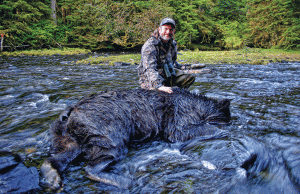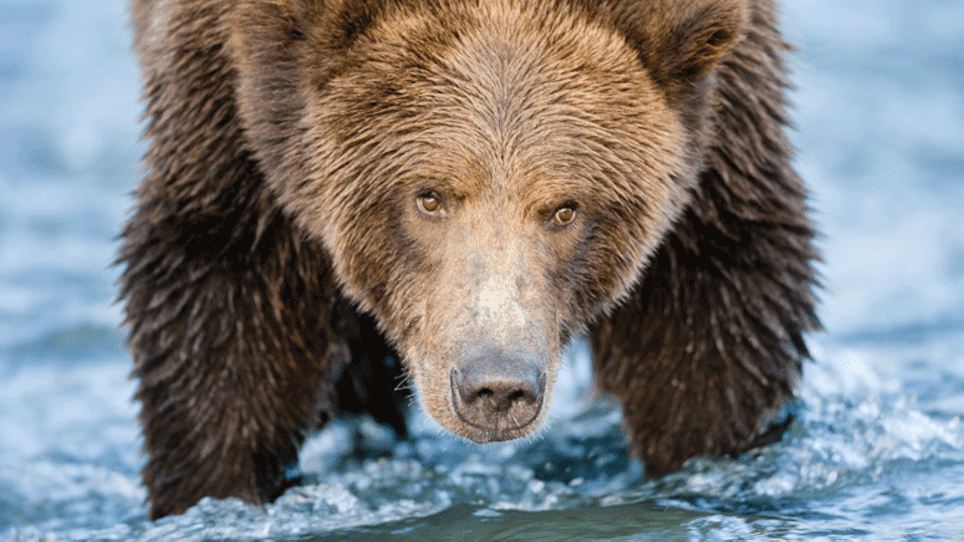Let’s cut to the chase. The grizzly bear, Ursus arctos horribilis, one of the most magnificent animals in North America, has been coddled long enough. The time to resume hunting them in the Greater Yellowstone Ecosystem (GYE) is now.
A brief history lesson. When Lewis and Clark came through the neighborhood, the U.S. Fish & Wildlife Service (USFWS) estimates there were upwards of 60,000 grizzly bears living between the Pacific Ocean and Great Plains. Settlers shot them on sight, and in 1975, when there were estimated to be only 180-220 of them left in the GYE, grizzlies were listed as a threatened species and given federal protection under the Endangered Species Act in all states except Alaska.
Of 37 distinct grizzly populations present in 1922, 31 were completely wiped out by 1975. While exact numbers are impossible to find, today reports tell us the region supports an estimated 1,000-1,500 wild grizzly bears, with distribution primarily within, but not limited to, the areas identified as “Recovery Zones,” including the Yellowstone area in northwest Wyoming, eastern Idaho and southwest Montana (9,200 square miles); the Northern Continental Divide Ecosystem of northcentral Montana (9,600 square miles); the North Cascades area of northcentral Washington (9,500 square miles); the Selkirk Mountains area of northern Idaho, northeast Washington and southeast British Columbia (2,200 square miles); and the Cabinet Yaak area of northwest Montana and northern Idaho (2,600 square miles). In the GYE itself, it is estimated that about 700-750 grizzlies reside there. In 1981, the USFWS hired a grizzly bear recovery coordinator to direct recovery efforts and coordinate all agency efforts on research and management of grizzly bears in the lower 48 states. The initial Grizzly Bear Recovery Plan was completed in 1982.
The recovery of the grizzly is easily one of the greatest wildlife conservation success stories in the last 100 years, so much so that the USFWS has maintained that since 2007 the GYE grizzly population and their habitat have recovered enough so that the bears could be placed under state management plans. They were removed from the endangered species list from 2007 to 2009, when rumblings of strictly limited hunting seasons began. But then the Greater Yellowstone Coalition (www.greateryellowstone.org) sued on the grounds that the federal government had not considered the rapid decline of the whitebark pine, a food source for the bear, or included an adequate response plan should the bear population go south. In 2009 the district court in Missoula, Montana, agreed, and the government then appealed the decision to the Ninth Circuit Court of Appeals, which upheld the district court in November 2011. The three-judge Ninth Circuit Court panel bought into the conservationists’ position that the decline in some of the grizzly’s natural food sources would likely drive them to forage in more populous areas around the park, increasing incidents of confrontation between humans and bears while rejecting the USFWS argument that the bears are omnivores and are doing just fine in Glacier National Park, where whitebark pine trees have already disappeared. The court did not accept that analysis, saying that ecosystems in the parks were different and more study was needed.
But while “more study is needed,” grizzlies continue to expand their range well outside national park boundaries. In the 1970s, their estimated range encompassed nearly 6,000 square miles. Today, grizzly bears occupy about 22,000 square miles, nearly four times as much. As this range continues to expand, both human activity in grizzly country and conflicts between the two continue to rise.
In summer 2011, grizzlies killed two hikers in Yellowstone National Park; it was the first time grizzlies killed anybody inside the park boundary in 25 years. In all, there were reports of nine people being injured or killed by grizzly bears in 2010 in the GYE, with 11 more injured or killed the next. And elk hunters continue to have many more encounters with grizzly bears outside park boundaries, sometimes with tragic results.
In mid-September 2011, two hunters shot what they thought was a black bear near the Idaho/Montana/Canada border – an area where no grizzlies were supposed to be – and, after tracking it into thick cover, the grizzly bear charged and began mauling 39-year-old Steve Stevenson. Stevenson’s hunting partner shot the bear several times, but one of his bullets passed right through the 400-pound grizzly bear and ended up killing Stevenson. Just eight days later, on September 24, 40-year-old elk hunter Richard Paini of Island Park, Idaho, sustained puncture wounds to his right forearm and left hand while hunting with John Stiehl. The pair had surprised a bear, which then circled before attacking Paini. Fortunately, Stiehl was able to chase the bear off with bear spray. Then, according to an account in the October 24, 2011, edition of the Spokane Spokesman-Review, 31-year-old Anthony Willits was bitten on the lower left leg by a sow grizzly with two cubs when he and his 29-year-old hunting partner, Gregory Louden, were returning to pack out meat from an elk they’d killed about 40 miles east of Kalispell. The hunters shot the bear once as it attacked, then Louden shot three more times after Willits was bitten, killing the bear. More recently, in August 2015, 63-year-old Lance Crosby of Billings, Montana, was killed by a grizzly while jogging inside Yellowstone Park. That same month, a grizzly wandered into the Soda Butte campsite near Yellowstone in Cooke City, Montana, attacking three tents, killing one camper and injuring two others. The list goes on.
Many experienced elk hunters or elk outfitters that frequent this region have stories of encounters with the big bears. Many will tell you that once an elk has been killed, you had best get it packed out right away, that leaving any meat overnight is like ringing a dinner bell for the local grizzlies. And once a bear claims the elk carcass, the hunter is forced to abandon his very expensive and hard-won prize.
It’s also a fact that in the areas in and adjacent to the GYE, the best wild land habitat is full of bears, forcing some of the animals to move onto farms and into residential areas, especially those areas dominated by agriculture and with little cover for wildlife. That forces game and fish departments to trap and relocate these potentially problem bears – Wyoming Game and Fish relocates, on average, about two dozen bears a year, for example – at great cost to the taxpayer, or kill those that keep returning to areas populated by people. And there’s no guarantee that a relocated bear will not return to populated areas in short order.
As of June 2016, 11 bears had died within the GYE; in 2015, that number was 61. Most of the deaths were at the hands of humans; most of these bears had killed livestock or become habituated to human food sources, according to information posted on the Interagency Grizzly Bear Study Team’s website (www.usgs.gov/science/interagency-grizzly-bear-study-team). Some bears died of natural causes, and a few were hit by vehicles. One female with three cubs was killed in self-defense by a hunter on November 15, 2015, on private land near Soldier Creek, Montana.
 In terms of elk mortality, grizzly bears are not nearly the problem that wolves are. Except for killing young calves, grizzlies are more likely to let wolves, lions and hunters do the killing for them before taking over the gut pile or carcass. But that’s not the point. The point is that the grizzly bear has recovered far beyond anyone’s wildest dreams, and it needs to be managed like all other big-game species. The best management tool is controlled hunting. If hunting permits are issued, then sportsmen will support the grizzly population because they will become stakeholders. That’s not the case today.
In terms of elk mortality, grizzly bears are not nearly the problem that wolves are. Except for killing young calves, grizzlies are more likely to let wolves, lions and hunters do the killing for them before taking over the gut pile or carcass. But that’s not the point. The point is that the grizzly bear has recovered far beyond anyone’s wildest dreams, and it needs to be managed like all other big-game species. The best management tool is controlled hunting. If hunting permits are issued, then sportsmen will support the grizzly population because they will become stakeholders. That’s not the case today.
The truth is that grizzly bears — one of the most magnificent animals on the continent — have become another pawn in a game played by animal-rights activists and anti-hunters on one side, and the rest of us who understand that in this modern world of an increasing human population you cannot have unchecked populations of large carnivores on the other. Grizzly bears, like wolves and mountain lions, must be managed by state game department biologists to maintain a healthy balance that will ensure quality habitat, healthy prey populations, and the ability for humans to enjoy the wild country without fear of being attacked by a grizzly bear or, if a conflict does occur, being prosecuted by an overzealous legal system that puts the rights of bears over the rights – and safety – of people.
The affected states agree. Late last year the Wyoming, Montana, and Idaho game departments began drafting an agreement they hope will spur the federal government to allow grizzly bear hunting around Yellowstone and Grand Teton national parks. Leaders of the states’ wildlife agencies wrote U.S. Fish and Wildlife Service Director Dan Ashe on December 7 saying the proposed agreement would provide necessary “clarity and transparency” as federal Endangered Species Act protections are lifted for grizzlies. The agreement seeks to satisfy federal requests for more rules to protect grizzlies before management is turned over to states and hunting could begin. A cover letter urges the federal government to remove the bear from the threatened species list, saying delays are “needlessly straining relationships vital to responsible grizzly bear management.”
The three states would aim for a total population of 600 to 747 grizzlies and would halt “discretionary mortalities,” including hunting, when grizzlies number fewer than 600 within the federal 19,279-square-mile “demographic monitoring area” around Yellowstone and Grand Teton national parks.
Of course, the “usual suspect” anti-hunting groups are screeching against a hunt of what would be classified as a “trophy game animal.” “The federal government is rushing to delist, to turn management over to the states,” Nicole Paquette, vice president of wildlife protection at the HSUS, said. “And the states are just going to set up trophy hunting.”
How will a grizzly hunt affect the overall population? Much depends on the details of the state management plans, according to Kerry Gunther, a bear management biologist who has studied grizzlies at Yellowstone for more than 33 years. If states only allow hunting in areas where grizzlies are already killed because of human-bear conflicts, for example, it’s far less likely to reduce bear numbers by much or to remove more adult males and cause influxes of young males, he noted. As another example, the locations where Montana allows hunting will be crucial in determining whether the Greater Yellowstone Ecosystem bears can expand north and link up with the thousand or so bears in the Northern Continental Divide on the Canadian border, increasing the populations’ genetic diversity.
And can you imagine how much revenue could be raised for conservation efforts through the sale of grizzly tags, especially to nonresidents, and by auctioning a couple to high-roller hunters at places like the Safari Club International and Rocky Mountain Elk Foundation annual conventions? Hundreds of thousands of dollars would be brought in rather than spending hard-to-find conservation dollars on bear relocation efforts and/or having the government kill more problem bears.
Enough is enough. The time to begin a tightly controlled, well-regulated grizzly bear hunting program in the Yellowstone ecosystem is now. What do you think? Drop me a note at brobb@grandviewmedia.com and let me know.






